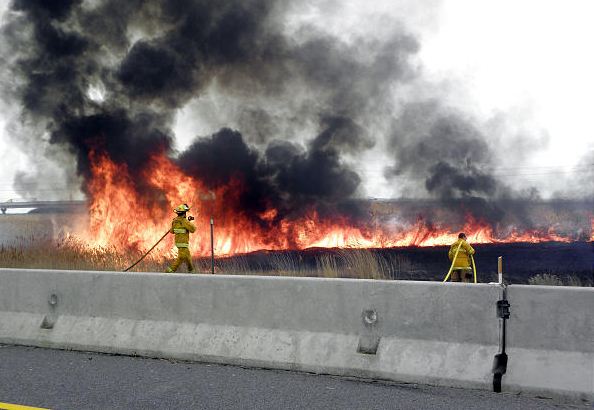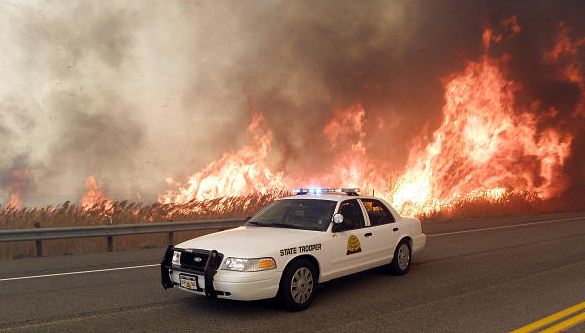In May, 2008, Wildfire Today wrote about two patents that were issued in the 1990’s for systems to deploy fire shelters, or fire-resistant blankets, to cover entire houses. These may or may not be feasible, but now the Federal Emergency Management Agency has awarded a $1 million grant to research the best material for whole-house fire-resistant blankets.
Author: Bill Gabbert
Three Wisconsin firefighters injured on wildfire
From the River Falls Journal in Wisconsin.
================================================
WAVERLY — One Elmwood firefighter was airlifted to Regions Hospital Wednesday evening and two others were transported to River Falls Area Hospital after several men were overcome by smoke while fighting a rural grass fire in eastern Pierce County.
Firefighter Tom Joyce, 38, remained hospitalized at Regions Thursday morning. His condition wasn’t available.
Fellow firefighters Jeremy Link and Travis Bemis were treated for smoke inhalation and heat exhaustion at River Falls and later released, according to Neil Gulbranson, a captain with the sheriff’s department.
Elmwood fire chief Mike Shields said two others were also affected by smoke but didn’t require medical transport.
Pierce authorities first received word from the pilot of a passing aircraft of a possible grass fire in the vicinity of 450th Avenue near CTH CC. The area is about a mile west of Nugget Lake County Park.
A deputy was sent to investigate and Elmwood firefighters were dispatched a short time later when a large grass fire was confirmed. Firefighters and all available ambulances from Ellsworth and Spring Valley were later called out to provide mutual aid.
About 20 minutes after arriving, an Elmwood fire officer notified Pierce dispatch that a firefighter was suffering respiratory distress and a paramedic from the Ellsworth Area Ambulance Service was requested to intercept the ambulance to assist the patient.
Joyce was transported to Ellsworth for relay to a medical helicopter, which landed at the highway shop about 7:55 p.m.
Gulbranson said the cause of the fire was unknown.
Shields confirmed those details with a Herald reporter Thursday morning. He said the fire was contained to about 20 acres. He said 20 firefighters from Elmwood responded along with 17 from Spring Valley and 5 from Ellsworth.
Besides three taken to hospital, two others were affected but not transported.
Los Angeles to charge homeowners $13 brush inspection fee
The cash-strapped city of Los Angeles for the first time will begin charging residents living in a “wildfire danger zone” a $13 fee for having their home inspected for adequate fire clearance. Firefighters, earning overtime pay on their days off, will check to be sure flammable vegetation within 200-feet of the structures has been cleared.
If the home fails the first inspection the resident will be charged a $300 re-inspection fee. If the city has to hire a contractor to do the work, the homeowner will have to pay a $1,112 administrative fee plus the cost billed by the contractor.
A homeowner can avoid the $13 inspection fee by doing a self-inspection, but they have to provide a signed affidavit, a copy of the Tax Assessor’s map of the property, and photographs showing that the work has been done.
Fire near Salt Lake City burns marina structures

A fire near Salt Lake City yesterday burned 50 acres, and buildings at the Great Salt Lake Marina including two maintenance shops owned by the Department of Natural Resources, two other small buildings, and sections of a Union Pacific rail line. The fire led to the closure of the nearby Interstate 80 and state Routes 201 and 202.
It could have been worse, if not for the quick work of firefighters.
“I’m quite pleased, actually,” said Bob Rosell, manager of the Great Salt Lake Marina. “We missed getting any boats damaged.”
Mr. Rosell probably considers a glass of water half full.

More photos.
New “Minimum Standards for Medical Units”
The National Wildfire Coordinating Group has issued a new document titled Minimum Standards for Medical Units Managed by NWCG Member Agencies. Your first thought might be that this is a response to the death of firefighter Andrew Palmer who, three hours and 20 minutes after being struck by a falling tree, bled to death while he was being transported in a Coast Guard helicopter (which responded staffed by a rescue swimmer) to the Redding, California airport. But the document states that it is being published “after years of hard work”, and does not say it is because horrendous errors were exposed during the Andrew Palmer tragedy.
I am no medical expert…I used to teach Advanced First Aid and my EMT expired a long time ago. The new standards are only a very small step in the right direction. It covers credentials, scope of practice, and some very basic principles of communication and patient transportation. But it does not cover to what degree Emergency Medical Services will be provided to fire line personnel, minimum EMS staffing for fires, or minimum time standards for treating and transporting patients.
Nor does it cover many of the principles that Andrew Palmer’s brother, Rob, outlined in his “2009 National Wildland Fire Reform: The Palmer Perspective”, such as transporting a severely injured firefighter to an appropriate medical facility during the “golden hour”.
There is a statement on page 14:
Following the adoption of the Minimum Standards for Medical Units Managed by NWCG Member Agencies, the IEMTG will develop NWCG Wildland Fire EMS Protocols.
Maybe that Protocol document, if and when it is developed, will be the meaningful one.
The NWCG needs to take the final step and address the issues that affect the treatment of firefighters during the “Golden Hour”. I used to tell my firefighters, “If we can’t do it safely, we won’t do it”.
Wildland firefighters face safety issues that have never been considered by urban firefighters. If a firefighter working on a structure fire is injured, a ground ambulance can access the patient 99.9% of the time. Almost by definition, where there is a structure, there is a road to it, so transporting an injured structural firefighter to a hospital within the Golden Hour is rarely a problem. And a landing zone for an EMS helicopter is usually within five minutes from the site of the accident by ground ambulance.
The NWCG agencies must develop an Emergency Medical System for firefighters that is unprecedented for civilian agencies. To ignore this issue, or delay it for years, would be negligent.
It may be difficult for executives in the federal land management agencies, whose expertise may be as a biologist or forester, to wrap their thoughts around how to adequately treat a firefighter who is seriously injured in the middle of a wilderness area. A person has to wonder if this issue would have been already addressed if wildland firefighters were part of their own fire management agency, rather than being farmed out to an assortment of land management agencies run by -ologists.
The military has been successfully and rapidly treating their injured warriors since the 1960’s. The NWCG needs to borrow their ideas and provide a safer working environment for wildland firefighters. Immediately.
The NWCG, including the National Park Service, US Fish and Wildlife Service, Bureau of Land Management, Bureau of Indian Affairs, and the US Forest Service, needs to immediately create a task force that will work full-time to create a policy that will address these issues.
Thermal thinning and the art of fire
Every now and then I run across a wildland fire term that is new to me. For example, “pyrodiversity“, from a few months ago, or allowing fire to “visit” an area, from about 10 years ago.
Well, here’s another one, “thermal thinning”, from an article about prescribed fire on the South Carolina Department of Natural Resources web site. An excerpt:
According to [Johnny] Stowe, prescribed fire can also be used in more sophisticated ways—for example, to prune and thin stands of longleaf pine. The ability of fire to kill or topkill (which inhibits growth) of hardwoods such as red maple, sweetgum, water oak and other species that are generally undesirable in longleaf woodlands and savannas, is well known. Less well-known is the artful use of fire to prune the lower limbs of young longleaf pines; to reduce the number of trees in longleaf stands that are too dense; and to remove other pine species, particularly loblolly, from these stands.
I like the fact that they referred to “the artful use of fire”. And it’s true. Planning and igniting a prescribed fire is as much an art as it is a science, and you can’t become expert in the art of fire from books, classes, or four or five seasons of work as a firefighter. In prescribed fire, you are sometimes dealing with the micro-aspect of fire–the flame length, flame height, residence time, temperature, and how those and other factors will affect the vegetation over the short and long term. And these fire effects and fire behavior on a micro-scale can’t always be predicted using computer programs such as BEHAVE. And if you think of fire as a “dragon”, you will never become artful in using it as a tool.
Fire suppression, in my mind, is less about the micro-aspect of fire. It is a lot more about the science than the art of fire. In suppression, you are using science (whether you know it or not), aided by your experience and the “slides” in your memory bank, to predict what the fire will do and where it will be at a particular time, while you select the most appropriate tool you have available to remove or cool the fuel adjacent to or ahead of the fire.
